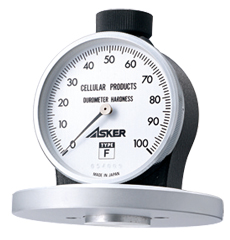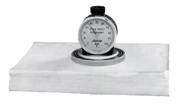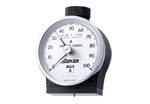ASKER Durometer Type F
The ASKER Durometer Type F for much softer specimens (low hardness) gives accurate readings as it features a larger indentor and pressure foot.
The durometer exclusively for various foam materials such as urethane foam, sponge, etc.
There is no need to press the durometer into the specimen, but just to place it onto the specimen. As it is soft, the weight of the durometer constitutes the pressure to the specimen.

Features
Indentor
Height: 2.54mm Shape: Cylindrical
Pressure foot

The pressure foot in contact with a specimen is 80mm in diameter, wide enough to offer a stable measurement by placing it onto the specimen.
Hardness Tester Selection Chart

Our product line consists of various types of durometers applicable to specific materials as indicated in the chart above.
Type A Durometer (ASKER A type), conforming to JIS K 6253-3 is the most popular type of durometer for measuring rubber hardness.
However, verification is recommended because a significant difference is estimated to be the largest when a durometer indicates measurement values from 10 to 90 points.
For hard specimens for which Type A Durometer readings indicate more than 90 points, measurements should be undertaken using the Type D Durometer (ASKER D type). However, for soft specimens with measurements of less than 20 points, the ASKER C type or Type E Durometer (ASKER E type) should be used. The most important consideration in using durometers is to select the correct type for purposes of measurement according to the specimen.
Specification
- Indication range
- 0 point - 100 point (262 degree dial scale)
- Minimum indication
- 1 point (Accuracy : ±1 point)
- Indentor Design (mm)
- Height: 2.54 25.2 Dia. Cylindrical
- Spring Forces [mN(g)]
-
- 0 point:
- 539(55)
- 100 point:
- 4460(455)
- Central hole of diameter of Pressure foot
- Φ26
- Pressure foot Dimension (mm)
- Φ80(Round shape)
- Outer Dimension (mm)
- Approx. Width 80×Depth 80×Height 81
- Weight (g)
- 500
- Application
- urethane foam, sponge, nnwoven fabric
Option

Two-pointer type (max-hand and active hand) of Rubber Hardness Tester
The stationary set hand (max-hand) makes the maximum value easier to read and allows the creep characteristics of a specimen.
Accurate measurement is made possible for specimens* for which stress relaxation occurs over time or for specimens for which it is difficult to take readings from the front.
*Materials for which the reading decreases immediately after the indentor has been pressed against the surface.